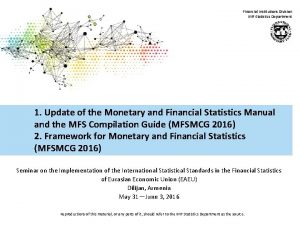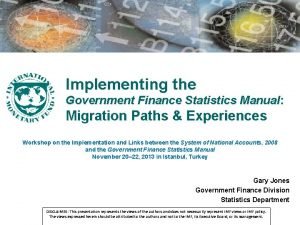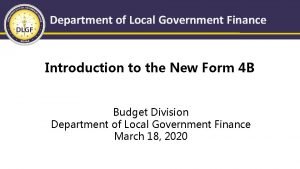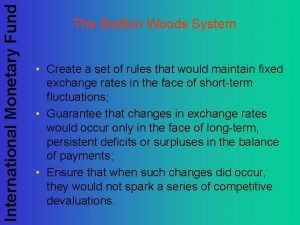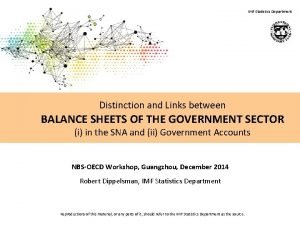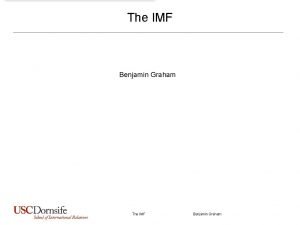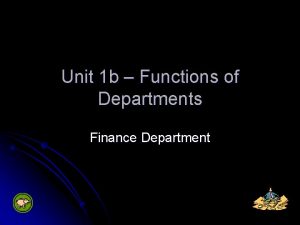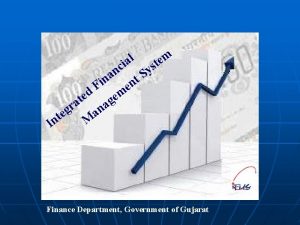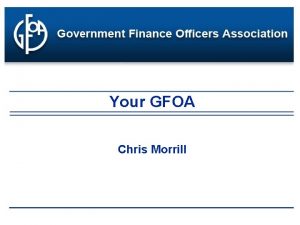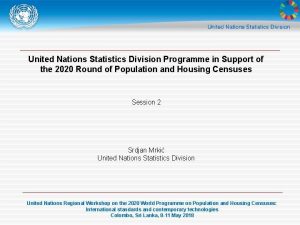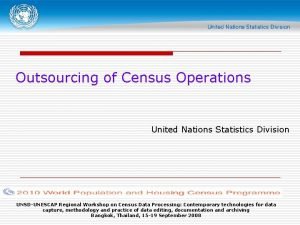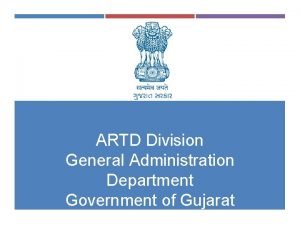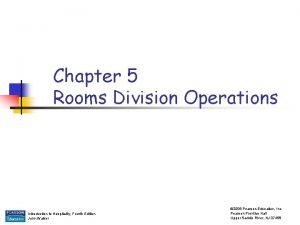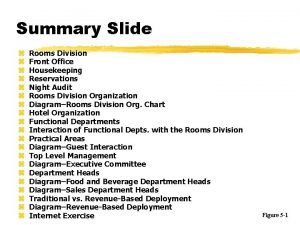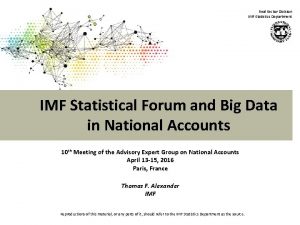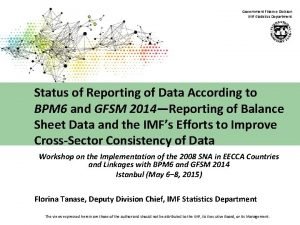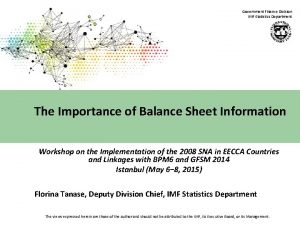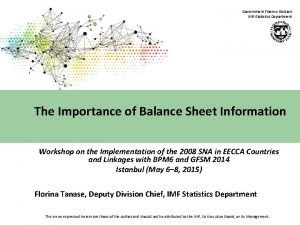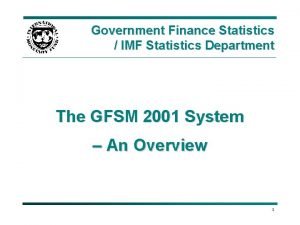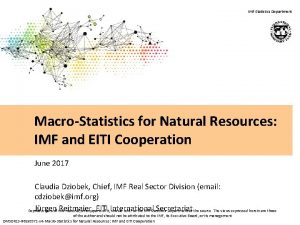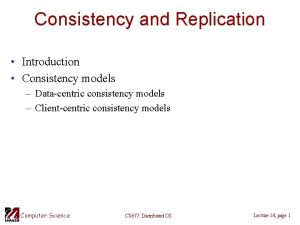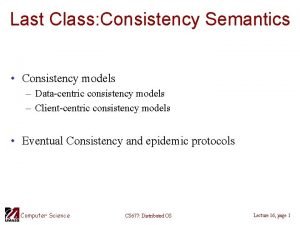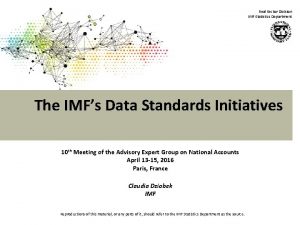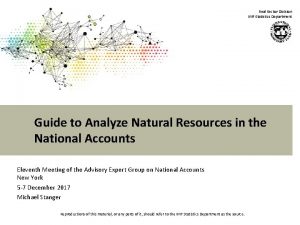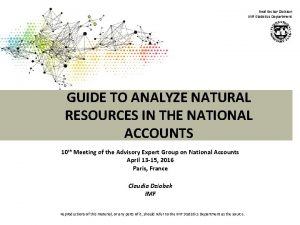Government Finance Division IMF Statistics Department Consistency Across






























































- Slides: 62

Government Finance Division IMF Statistics Department Consistency Across Macroeconomic Datasets Seminar on the Implementation of the International Statistical Standards in the Financial Statistics of Eurasian Economic Union (EAEU) Dilijan, Armenia May 31-June 3, 2016 Reproductions of this material, or any parts of it, should refer to the IMF Statistics Department as the source.

Government Finance Division IMF Statistics Department Outline § Linkages among macroeconomic statistics datasets • General overview • International accounts and the links with the SNA • International accounts and the links with the GFS • International accounts and the links with the MFS § GFS and the links with SNA and MFS 2

Government Finance Division IMF Statistics Department General Overview § SNA is the “central” statistical system • Except for a few differences, all Fund statistical systems (GFS, BOP, MFS) are generally consistent with SNA in respect of v v v v Residency Institutional units and sector Valuation Time of recording Definitions of assets and liabilities Accounting rules Use of a stocks and flows approach 3

Government Finance Division IMF Statistics Department Linkages Among Macroeconomic Statistics National Accounts Final Consumption Government Private Gross domestic investment Government Private Exports Imports Gross Domestic Product Net factor income Net current transfers Gross National Disposable Income Government Finance Revenue and grants Expenditure Current expenditure Wages/salaries Goods/services Interest Capital expenditure o/w fixed capital formation Net lending/borrowing External Domestic Balance of Payments Current account: Exports Imports Income Net current transfers Capital account Financial grants, etc Financial account/IIP Direct investment Net foreign financing Nonfinancial sector Government Financial sector (not central bank) Change in reserves MFS (derived flows/stocks) Net foreign assets Central bank Rest of financial sector Net domestic credit Non Financial Public Non Financial Private Government Other assets, net medium/long term foreign liab 4

Government Finance Division IMF Statistics Department International Accounts (IA) and System of National Accounts (SNA) 5

Government Finance Division IMF Statistics Department 6

Government Finance Division IMF Statistics Department Components of the Current Account G= Government consumption expenditure I= Gross domestic investment Ip = Private domestic investment Ig = Government domestic investment S= Saving Sp = Private saving Sg = Government saving X= Exports of goods and services M = Imports of goods and services NPI = Net primary income Y= GDP GNDY = Gross national disposable income GNDYp = Private disposable income R= Government disposable income CAB = Current account balance NSI = Net secondary income NKT = Net capital transfers NPNNA =Net purchase of non-produced, nonfinancial assets NFI = Net foreign investment or net lending/net borrowing vis-à-vis the rest of the world 7

Government Finance Division IMF Statistics Department Components of the Current Account GNDY = C + G + I + X - M + NPI + NSI GNDY - C - G = S S = I + X - M + NPI + NSI S - I = X - M + NPI + NSI = CAB In this formulation the current account balance could be approximated as the excess of domestic saving over domestic investment. S - I = CAB but S = GNDY - C - G - (I p + Ig) = CAB GNDY = GNDYp + R GNDYp - (C + Ip) + R - (G + I g) = CAB GNDYp - (C + Ip) = Private disposable income - private expenditure R - (G + Ig) = Government surplus/deficit In this formulation the current account balance could be viewed as the sum of sectoral imbalances. S - I + NKT - NPPNA = CAB + NKT - NPPNA = NFI (NKT - NPPNA = balance of the capital account of the balance of payments) 8

Government Finance Division IMF Statistics Department HARMONIZATION OF IA WITH THE SNA § Complete concordance between the 2008 SNA and BPM 6

Government Finance Division IMF Statistics Department IA-SNA: Main differences § Reversal of Recording • SNA: current account entries are resources and uses • BOP: current and capital account entries are credits and debits • Reverse recording: v v a credit for the national economy in the BOP is treated as a use by the ROW in the SNA; a BOP debit is a resource in the SNA Similarly, liabilities of the compiling economy against non-residents (BOP) are financial assets for the ROW (SNA) and vice versa § Classifications • Major presentational difference: grouping of financial assets and liabilities by functional categories—primary level of classification in BPM 6 • v impact on financial account, IIP and categories of investment income Breakdown of institutional sectors and their groupings according to importance but consistency in coverage (see Table A 6. 1 in BPM 6 CG) § Balance sheet (SNA) – IIP • Non-financial assets in BS but not in IIP • Net worth (SNA) vs. Net IIP 10

Government Finance Division IMF Statistics Department Accounting Structure Comparative Overview: SNA – IA (1/6) Current accounts *) Rest of the world, as a pseudo sector in the SNA, records flows reaching/leaving the national economy from/to the rest of the world 11

Government Finance Division IMF Statistics Department Comparative Overview: SNA – IA (2/6) Current accounts (contd. ) 12

Government Finance Division IMF Statistics Department Comparative Overview: SNA – IA (3/6) Current accounts (contd. ) 13

Government Finance Division IMF Statistics Department Comparative Overview: SNA – IA (4/6) Accumulation Accounts: Capital Account 14

Government Finance Division IMF Statistics Department Comparative Overview: SNA – IA (5/6) Accumulation Accounts: Financial Account 15

Government Finance Division IMF Statistics Department Comparative Overview: SNA – IA (6/6) Balance sheets 16

Government Finance Division IMF Statistics Department IA and Government Finance Statistics (GFS) 17

Government Finance Division IMF Statistics Department Relationships between GFSM 2014 and BPM 6 GFSM 2014 BPM 6 Transactions Revenue account Expense account Nonfinancial assets Financial assets & liabilities Current account Operating balance Current account balance Capital account Other economic flows Closing balance sheet Current and capital account balance Financial Account Other economic flows International Investment Position (Closing balance Sheet) Net lending / borrowing 18

Government Finance Division IMF Statistics Department GFS and IA (1/2) § GFSM 2014 is largely consistent with 2008 SNA and BPM 6 § Linkages between BOP/IIP/External Debt Sector (EDS) and GFS (including Public Sector Debt (PSD)) are direct and allow direct comparison v To understand impact of government operations on external position of economy § BOP explicitly identifies general government in v v v Government goods and services n. i. e. in Goods and Services Account Current transfers in Secondary Income Account Capital transfers in Capital Account § BOP/IIP explicitly identifies general government in v Portfolio investments, financial derivatives, and other investment § External debt of the public sector is a subset of Total public sector debt 19

Government Finance Division IMF Statistics Department GFS and IA (2/2) § GFSM 2014 explicitly recognizes the ROW (mirror of IA): • Classification of financial assets/liabilities v • • stocks, transactions, revaluations, other changes in volume of assets & liabilities Grants revenue/expense v From/to foreign governments & international organizations Interest expense v to nonresidents § Implicitly – building block approach could accommodate other BOP reporting needs 20

Government Finance Division IMF Statistics Department GFS and the IIP (1/3) § Dimensions for the classification structure in IIP: • Functional categories • Financial Instruments • Institutional Sector • Maturity (short- and long-term) • Currency • Interest rate structure § Emphasis of GFSM 2014: financial instrument and § institutional sector New initiative “PSD Statistics Template” broadly consistent with IIP classification structure (introducing currency, interest rate, and maturity structure) 21

Government Finance Division IMF Statistics Department GFS and the IIP (2/3) IIP main instrument classification: Equity capital and investment fund shares • Equity (including shares and equity) • Investment fund shares/units Debt instruments* • Special Drawing rights • Currency and deposits • Debt securities • Loans • Insurance, pension and standardized guarantee schemes • Trade credit and advances • Other accounts receivable/payable Other financial assets/liabilities • Monetary gold • Financial derivatives and employee stock options * EDS and PSDS GFS main instrument classification: • Monetary Gold and SDRs • Currency and deposits* • Debt securities* • Loans* • Equity and investment fund shares • Insurance, pension, and standardized guarantee schemes • Financial derivatives and employee stock options • Other accounts receivable/payable* Domestic • Same instrument breakdown as above excluding monetary gold and SDRs Foreign • Same instrument breakdown as above 22

Government Finance Division IMF Statistics Department GFS and the IIP (3/3) IIP (EDS) main sector classifications: • Central bank • Deposit-taking corporations except the Central Bank • General government • Other sectors • Other financial corporations • Nonfinancial corporations, households, and NPISHs* GFS (PSDS) main sector classifications: • General government (central, state and local governments breakdown) • Nonfinancial public corporations • Financial public corporations *EDS three subsectors instead of 2. 23

Government Finance Division IMF Statistics Department EDS and PSDS (1/4) External Debt Statistics definition: Public Sector Debt Statistics definition: Gross external debt, at any given time, is the outstanding amount of those actual current, and not contingent, liabilities that require payment(s) of interest and/or principal by the debtor at some point(s) in the future, that are owed to nonresidents by residents of an economy All liabilities of the public sector that require payment(s) of interest and/or principal by the debtor to the creditor at a date in the future • Thus, all liabilities (foreign or public) are debt, except for • Shares and other equity • Financial derivatives 24

Government Finance Division IMF Statistics Department EDS and PSDS (2/4) § Gross vs. net debt • Net debt = gross debt – corresponding financial assets v Symmetric treatment for liabilities and financial assets v Net debt, relevant concept for fiscal sustainability analysis as a proxy for financial net worth v Gross debt may be an acceptable proxy for net debt of general government (depending on the ratio of assets to debt) 25

Government Finance Division IMF Statistics Department EDS and PSDS (3/4) External debt: Public Sector debt: • Coverage • General government identified separately • Consolidation • Consolidated data for general government • Valuation • Nominal vs. market values • Residency • Only transaction with nonresidents • Coverage • General government and public sector • Consolidation • Unconsolidated and consolidated data • Valuation • Nominal vs. market values • Residency • Domestic and foreign 26

Government Finance Division IMF Statistics Department EDS and PSDS (4/4) External debt classification: Public Sector debt classification: • Institutional sector based approach: • General government • Central bank • Deposit Taking Corporations, except the Central Bank • Other public sector not specified (nonfinancial corporations, etc) • Public sector based approach • Public and publicly guaranteed external debt • Non-guaranteed private sector external debt • Maturity (short- long term) • Currency (not prescribed) • Interest rates (not prescribed) • Sector • General government • Central, state and local government • Nonfinancial public corporations • Financial corporations Public guaranteed debt as memo items • Maturity (short-long term) • Currency (domestic-foreign) • Interest rates (fixed-flexible) 27

Government Finance Division IMF Statistics Department IA and Monetary Finance Statistics (MFS) 28

Government Finance Division IMF Statistics Department Linkages Between MFS and IA: Common Principles and Differences § Most recent methodology for compiling MFS: MFSMCG 2015 • • Focus on: balance-sheet data (end-of-period positions) for the central bank and other depository corporations But the other financial corporations (OFCs) increasingly covered § Broad consistency of MFSMCG with 2008 SNA and BPM 6: • definition and delineation of resident and nonresident entities, • time of recording of transactions and other flows, • valuation of financial asset and liability, and • data aggregation and consolidation § However, some differences in: § sectorization of the institutional units § classification of financial assets and liabilities 29

Government Finance Division IMF Statistics Department Linkages Between MFS and IA: Differences in Sectorization Definition of other depository corporations: § MFS: all financial corporations that issue liabilities included in broad money • • These include the central bank, the other deposit-taking corporations, and, in many economies, money market funds In BPM 6, money market funds are not consolidated with deposit-taking corporations but with other financial corporations. v • Request separate data on money market funds balance of payments transactions and IIP Also, confirm the institutional coverage of the deposit-taking corporations subsector, as some deposit-takers may be excluded, such as offshore banks. 30

Government Finance Division IMF Statistics Department Linkages Between MFS and IA: Differences in the Classification of Financial Assets and Liabilities § Classification by maturity—The standard components in the MFSMCG do not include loans and debt securities classified by maturity, although the SRFs include some breakdowns § Classification by currency of denomination—MFSMCG requires a breakdown of all instruments, financial assets and liabilities, except equity liabilities, into: • • national currency, and foreign currency 31

Government Finance Division IMF Statistics Department Limitations in Using MFS for the IIP, and how to Overcome them Limitations: § Valuation § Coverage/Sector classification § Functional categories § Maturity breakdown 32

Government Finance Division IMF Statistics Department Limitations in Using MFS: Valuation § In MFS, liabilities in the form of equity are measured at § book value and classified by types of equity resources (i. e. , funds contributed by owners; retained earnings; general and special reserves; and valuation adjustments). Therefore, the value of the equity issued by the domestic financial system and held by nonresidents is not identified • • SRFs contain a memorandum item requesting the market or fair value of equity liabilities by counterpart sector However, very few economies provide this information v v IIP coordinate with MFS counterparts to promote the compilation of the referred SRF memorandum item, thus avoiding duplication of efforts Foreign liabilities in MFS are often underestimated 33

Government Finance Division IMF Statistics Department Limitations in Using MFS: Coverage § In some countries, OFC data reporting for MFS is § § incomplete or is not performed on a timely basis Instead, OFCs report to specialized supervisory agencies, for example supervisors of insurance corporations or pension funds. Recommendation: coordinated effort to gather OFCs data for MS and IIP purposes, either from supervisory agencies or direct reporting. • Both MFS and IIP have a common interest in a complete data coverage 34

Government Finance Division IMF Statistics Department Limitations in Using MS: Functional Categories § MFS do not use functional categories to classify financial assets and liabilities • • Direct investment relationships not available • Definition of control and significant influence in the BPM 6 do not entirely correspond to the definitions found, for example, in the international financial reporting standards (IFRS) However, the emphasis on group consolidated supervision of the financial sector made the relationship between parent, subsidiary, and associate financial corporations broadly available as subaccounts within the accounting chart of accounts used by financial corporations v But good enough proxy for economies with limited resources 35

Government Finance Division IMF Statistics Department Limitations in Using MFS: Maturity Breakdown § SRFs contain maturity breakdown only for central bank liabilities with nonresidents, but not for financial assets or for assets and liabilities in other financial subsectors § Supervisory data often used to compile the monetary statistics present the short and long-term breakdowns required by BPM 6 • These breakdowns are often available to the monetary statistics compiler § New MFS requirements focused on financial stability analysis, particularly on liquidity, are putting emphasis on the availability of maturity breakdowns useful for the compilation of the IIP 36

Government Finance Division IMF Statistics Department Reconciliation Exercise Between MFS and IIP 37

Government Finance Division IMF Statistics Department Reconciliation exercise between MFS and IIP (2/2) 38

Government Finance Division IMF Statistics Department GFS and the System of National Accounts 39

Government Finance Division IMF Statistics Department GFS and SNA § Main difference = consolidation • GFS => full consolidation • SNA => not used, generally § Hint: as consolidation in GFS takes place after the statistics have been compiled for each unit, unconsolidated statistics should be preserved for use by the NA compilers! 40

Government Finance Division IMF Statistics Department GFS and SNA Analytical framework § Both systems record stocks and flows (transactions/other economic flows) § Actual flows recorded differ: • Different sequences of accounts • Different recording practices • Single vs. Multiple entries for certain single transactions 41

Government Finance Division IMF Statistics Department Relationships between GFSM 2014 and 2008 SNA GFSM 2014 SNA Transactions Revenue account Expense account Nonfinancial assets Financial assets & liabilities Production account Income account Operating balance Other economic flows Closing balance sheet Capital transfers & nonfinancial assets Financial assets & liabilities GDP (value added) Saving Other economic flows Closing balance sheet Net lending / borrowing 42

Government Finance Division IMF Statistics Department GFS and SNA Different sequences of accounts § GFS = four statements: • Statement of operations • Statement of other economic flows • Balance sheet • Statement of sources and uses of cash 43

Government Finance Division IMF Statistics Department GFS and SNA Different sequences of accounts § SNA (Figure A 7. 1 in GFSM 2014, Appendix 7): • Transactions = sequence of seven accounts • Other economic flows = two accounts • Stocks positions = Balance sheet (opening and closing) • No equivalent for the GFS Statement of sources and uses of cash 44

Government Finance Division IMF Statistics Department GFS and SNA Different recording practices § GFS = double entry recording (= business accounting) § SNA = quadruple entry recording = 2 entries (like in GFS) x 2 institutional units 45

Government Finance Division IMF Statistics Department GFS and SNA Identical Items Item GFSM Code SNA Code Taxes 11 D. 2 + D. 51 + D. 59 + D. 91 Taxes on income, profits an capital gains 111 D. 51 Import duties 1151. 1 D. 2121 Subsidies 25 D. 3 Rent 2814 D. 45 Net acquisitions of fixed assets, inventories and valuables 311, 312 and 313 P. 511, P. 512, P. 513 Most other economic flows Most financial assets / liabilities 46

Government Finance Division IMF Statistics Department GFS and SNA § Selected Differences • Entirely different measures v v • Different definitions or breakdowns v v • Output Consumption Taxes Subsidies Conceptual Differences v v v Interest Compensation of employees Pensions 47

Government Finance Division IMF Statistics Department GFS and SNA § Output • Key concept in SNA v v • Output minus intermediate consumption = “value added” Gross Value Added across entire economy = GDP (O) Not recorded in GFS system but can be calculated v How do you record output anyway? v Market producers? § v Value of goods and services produced Nonmarket producers? § sum of production costs 48

Government Finance Division IMF Statistics Department GFS and SNA § Output (continued) • Sum of Production Costs = v v Compensation of employees + Intermediate consumption + Consumption of fixed capital + Other taxes on production paid, and other subsidies on production received 49

Government Finance Division IMF Statistics Department GFS and SNA § Consumption • Activity in which institutional units use up goods or services v v v Intermediate consumption Final consumption only recorded by households, government and NPISH units • Total final expenditure = alternate measure of the economy – the expenditure approach GDP (E) • Not recorded in GFSM, but can be calculated 50

Government Finance Division IMF Statistics Department GFS and SNA § Taxes • Taxes in GFS v v v • Taxes on income, profit and capital gains Taxes on payroll and workforce Taxes on property Taxes on goods and services Taxes on international trade and transactions Other taxes Taxes in SNA v v v Taxes on products Taxes on production Taxes on income, profits and capital gains Other current taxes Capital taxes Key issues for Taxes in SNA Paid by businesses or households? Ongoing or one off? 51

Government Finance Division IMF Statistics Department GFS and SNA § Subsidies • Subsidies in GFS v v v To public corporations To private enterprises To other sectors • Subsidies in SNA v v Subsidies on products Subsidies on production Key issues for Subsidies in SNA Paid per unit of good or service? Subsidies unrelated to specific products? 52

Government Finance Division IMF Statistics Department GFS and SNA § Interest • Key difference – adjustment for “FISIM” v “Financial Intermediation Services Indirectly Measured” • Interest also includes a service charge to the unit providing the loan – this isn’t “interest”, but use of goods and services • Insurance and pensions treated in similar way • Therefore FISIM also important factor in difference between GFSM use of goods and services and SNA intermediate consumption • Can be significant for countries with large interest costs 53

Government Finance Division IMF Statistics Department GFS and SNA § Own account capital formation • Recorded service in SNA, recorded once in GFSM – as acquisition of nonfinancial assets v Compensation of employees in SNA 2008 – entire “wage bill” In GFSM – excludes wages of government employees engaged in own account capital formation Further factor in difference between GFSM use of goods and services and SNA intermediate consumption Difference between SNA and GFSM Consumption of fixed capital. v 3 memo items to help bridge the numbers: v v v § § § 3 M 11 compensation of employees 3 M 12 intermediate consumption 3 M 13 consumption of fixed capital 54

Government Finance Division IMF Statistics Department GFS and SNA § Pensions • • • GFSM requires pensions for government employees (employment related pensions) be included as liabilities Optional in SNA Differences arise in: v v v • • Total liabilities (GFSM > SNA) Net incurrence of liabilities Social benefits Further differences due to recording convention Extra item in SNA – D 8 adjustment for pension entitlements 55

Government Finance Division IMF Statistics Department GFS and Monetary and Financial Statistics 56

Government Finance Division IMF Statistics Department What are MFS? § Financial Statistics • Encompass data on financial positions (and flows) of the financial and nonfinancial corporations § Monetary Statistics • Focuses in currency, deposits, and other monetary liabilities of depository corporations, and other issuers of monetary liabilities § Main reason for compiling MFS data: • provide quantitative information for the formulation, implementation, and monitoring of monetary and financial policies 57

Government Finance Division IMF Statistics Department Financial Corporations Sector § Uses same breakdown of financial corporations as SNA (more detailed than GFSM) § Includes enterprises engaged in: • Financial intermediation • Auxiliary financial services § Central Bank, other banks, insurers, pension funds, other financial intermediaries etc. 58

Government Finance Division IMF Statistics Department Deposit Corporations Survey (DCS) § Cover balance sheet data of central bank and other depository corporations § Used to identify key aggregates such as money supply, credit, debt, and foreign assets (of which international reserves are a major component) § Assets • Domestic assets v Net claims on central/general government § § v Gross claims on central/general government Gross liabilities to central/general government Claims on other domestic sectors 59

Government Finance Division IMF Statistics Department GFS and MFS § Important to know • From analytical point of view v • Evaluate impact of government on financial corporations sector From practical point of view v Evaluate consistency between financing requirements of government and MFS data § § Identity differences Eliminate or explain differences 60

Government Finance Division IMF Statistics Department Consistency between GFS and MFS (1/2) § In concept, GFSM 2014 and MFSM are almost fully harmonized • Same framework Opening balance sheet + Transactions + Other economic flows = Closing balance sheet • Same basis of recording (accrual) • Same sectorization • Same classification of instruments 61

Government Finance Division IMF Statistics Department Consistency between GFS and MFS (2/2) § If they do differ, the most likely causes are: • inconsistent coverage and sectorization v • misclassifications v • agreed list of government units needed e. g. , GFS data on holders of government securities based on primary market operations departures from accrual basis of recording v e. g. , interest accruals not incorporated as transactions 62
 Imf financial statistics
Imf financial statistics Imf
Imf Government finance statistics manual
Government finance statistics manual Eventual consistency vs strong consistency
Eventual consistency vs strong consistency Department of local government finance
Department of local government finance Roles of imf
Roles of imf Imf adalah
Imf adalah Concept of imfa
Concept of imfa Difference between imf and world bank
Difference between imf and world bank Materi lembaga keuangan internasional
Materi lembaga keuangan internasional Imf voting power
Imf voting power India imf loan history
India imf loan history Imf practice
Imf practice Wto objectives
Wto objectives Imf chemistry
Imf chemistry Imf system
Imf system Debt imf
Debt imf Lambang imf
Lambang imf Imf chemistry
Imf chemistry Imf
Imf Imf
Imf Imf
Imf Imf gdp per capita
Imf gdp per capita Molecular attraction
Molecular attraction Bretton woods system
Bretton woods system Mathematics for finance
Mathematics for finance Introduction to statistics what is statistics
Introduction to statistics what is statistics Finance department function
Finance department function Koshwahini ddo pending bill
Koshwahini ddo pending bill Finance department functions
Finance department functions Finance departments
Finance departments Department of finance and administration
Department of finance and administration State of alabama department of finance
State of alabama department of finance Meeting minutes
Meeting minutes Ms department of finance and administration
Ms department of finance and administration The four c's of healthcare finance
The four c's of healthcare finance Jackson state university finance department
Jackson state university finance department City of houston finance department
City of houston finance department Introduction to local government finance
Introduction to local government finance Cgfo exam study guide
Cgfo exam study guide Georgia government finance officers association
Georgia government finance officers association United nations statistics division
United nations statistics division United nations statistics division
United nations statistics division Peos
Peos Unified government public health department
Unified government public health department Artd gujarat
Artd gujarat State and federal constitutions
State and federal constitutions Mohari botanical name
Mohari botanical name Science dadeschools
Science dadeschools Department vs division
Department vs division Rooms division department
Rooms division department Room division department
Room division department Division of powers definition government
Division of powers definition government Division for public institutions and digital government
Division for public institutions and digital government 369 times 2
369 times 2 Example of synthetic division
Example of synthetic division Parts of long division
Parts of long division Stnthetic division
Stnthetic division What is verb tense consistency
What is verb tense consistency Will vs shall
Will vs shall What consistency is the brain
What consistency is the brain Feel and appearance of a surface
Feel and appearance of a surface Consistency is the last refuge of the unimaginative
Consistency is the last refuge of the unimaginative

